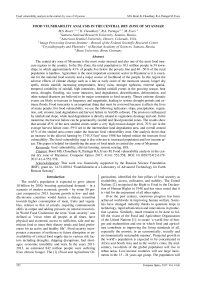Food vulnerability analysis in the central dry zone of Myanmar
Автор: Boori Mukesh Singh, Choudhary Komal, Paringer Rustam Aleksandrovich, Evers Mariele
Журнал: Компьютерная оптика @computer-optics
Рубрика: Image processing, pattern recognition
Статья в выпуске: 4 т.41, 2017 года.
Бесплатный доступ
The central dry zone of Myanmar is the most water stressed and also one of the most food insecure regions in the country. In the Dry Zone, the total population is 10.1 million people in 54 townships, in which approximately 43 % of people live below the poverty line and 40 - 50 % of the rural population is landless. Agriculture is the most important economic sector in Myanmar as it is essential for the national food security and a major source of livelihood of the people. In this region the adverse effects of climate change such as a late or early onset of the monsoon season, longer dry spells, erratic rainfall, increasing temperatures, heavy rains, stronger typhoons, extreme spatial-temporal variability of rainfall, high intensities, limited rainfall events in the growing season, heat stress, drought, flooding, sea water intrusion, land degradation, desertification, deforestation, and other natural disasters are believed to be major constraints to food security. Theses extreme climatic events are likely to increase in frequency and magnitude, leading to serious drought periods and extreme floods. Food insecurity is an important thing that must be reviewed because it affects the lives of many people. For food vulnerability, we use the following indicators: slope, precipitation, vegetation, soil, erosion, land degradation and harvest failure in ArcGIS software. The erosion is influenced by rainfall and slope, while land degradation is directly related to vegetation, drainage and soil. In the meantime, the harvest failure can be generated by rainfall and flood potential zones. The results show that around 45 % of the area studied comes under a very high erosion danger level, 70 % are in the average harvest failure zone, 59 % are in the intermediate land degradation area, and overall around 45 % of the studied area comes under the insecure food vulnerability zone. Our analysis shows that an increase in the alluvial farming by 1745.33 km2 since 1988 has helped reduce the insecure food vulnerability. The food vulnerability map is also relevant to increased population and low income areas. This paper is helpful for identifying the areas of food needs in central dry zone of Myanmar.
Food vulnerability, alluvial farming, remote sensing, gis
Короткий адрес: https://sciup.org/140228766
IDR: 140228766 | DOI: 10.18287/2412-6179-2017-41-4-552-558
Список литературы Food vulnerability analysis in the central dry zone of Myanmar
- FAO: FAOSTAT on the UN, Myanmar, Food and Agriculture Organization of the United Nations (FAO) . -URL: http://faostat.fao.org/CountryProfiles/Country_Profile/Direct.aspx?lang=en&area=28.
- United Nations Commission on Sustainable Development . -URL: https://sustainabledevelopment.un.org/csd.html.
- JICA. The development study on sustainable agricultural and rural development for poverty reduction programme in the central dry zone of the Union of Myanmar. Final report. -Report No: RD JR 10-502. -Japan International Cooperation Agency, 2010.
- World Bank. Myanmar -Ayeyarwady integrated river basin management project . -Report No: PAD987. -Washington, DC: World Bank Group, 2014. -URL: http://documents.worldbank.org/curated/en/347681468279901640/Myanmar-Ayeyarwady-Integrated-River-Basin-Management-Project.
- Haggblade, S. A strategic agricultural sector and food security diagnostic for Myanmar/S. Haggblade, D. Boughton, G. Denning, R. Kloeppinger-Todd, K.M. Cho, S. Wilson, L.C.Y. Wong, Z. Oo, T.M. Sandar, N.E.M.A. Wai, N.W. Win. -Michigan, USA: Michigan State University; Yangon, Myanmar: Myanmar Development Resource Institute -Centre for Economic and Social Development (MDRI-CESD). -2015. -URL: http://fsg.afre.msu.edu/Myanmar/myanmar_agricultural_sector_diagnostic_july_2013.pdf.
- LIFT dry zone programme framework . -URL: https://www.lift-fund.org/sites/lift-fund.org/files/uploads/Dry_Zone/Dry_Zone_programme_framework_-_24_April_15.pdf.
- Boori, M.S. Vulnerability analysis on Hyderabad city, India/M.S. Boori, K. Choudhary, A. Kupriyanov//Computer Optics. -2016. -Vol. 40, Issue 5. -P. 752-758. - DOI: 10.18287/2412-6179-2016-40-5-752-758
- Boori, M.S. Avaliação de impacto ambiental e gestão dos recursos naturais no estuário Apodi Mossoró, nordeste do Brasil/M.S. Boori. -Tese de Doutorado. -Tese N0 29/PPGG. -Natal-RN, Brazil: Universidade Federal do Rio Grande do Norte, 2011. -URL: https://repositorio.ufrn.br/jspui/bitstream/123456789/18360/1/MukeshSB_TESE.pdf.
- Widayani, P. Application of geographically weighted regression for vulnerability area mapping of Leptospirosis in Bantul District/P. Widayani, T. Gunawan, P. Danoedoro, S.J. Mardihusodo//Indonesian Journal of Geography. -2016. -Vol. 48, Issue 2. -P. 168-177. - DOI: 10.22146/ijg.17601
- WFP (World Food Programme). Food security assessment in the Dry Zone Myanmar . -URL: http://documents.wfp.org/stellent/groups/public/documents/ena/wfp234780.pdf.
- Boori, M.S. Monitoring land use/cover change detection through remote sensing and GIS techniques in Eastern Siberia, Russia/M.S. Boori, K. Choudhary, A. Kupriyanov, A. Sugimoto, V. Kovelskiy//SGEM2016 Conference Proceedings. -2016. -Vol. 2. -P. 971-978. - DOI: 10.5593/SGEM2016/B22/S10.124
- Boori, M.S. Natural and Environmental vulnerability analysis through remote sensing and GIS techniques: A case study of Indigirka River basin, Eastern Siberia, Russia/M.S. Boori, K. Choudhary, A. Kupriyanov, A. Sugimoto, M. Evers//Proceedings of SPIE. -2016. -Vol. 10005. -100050U. - DOI: 10.1117/12.2240917


